
The terms roast and bake refer to cooking meats or baked goods in an oven. Traditionally, roasting refers to cooking over an open flame or other heat source and relies on a source of fat, such as natural fats in meats or a drizzle of oil on vegetables, to produce a golden exterior. In contrast, baking relies on indirect heat. When it comes to convection ovens, the distinction between roasting and baking depends on the setting used.
Roasted to Perfection
Roasting produces meat or poultry with a browned exterior that is slightly crunchy. In a traditional oven, basting the meat with its own fatty juices speeds the browning process. However, in convection ovens, circulating air works to release the juices in the meat quickly and creates even browning of the meat. For veggies, lightly coating them with oil and seasonings is all that is needed before roasting. The circulating heat causes the sugars in the veggies to caramelize quickly before drying out, sealing in their natural juices.
Baked in Goodness
Baking generally refers to bread products, such as rolls, breads, cakes, cookies and muffins, although fish and other dishes can be bakes as well. Indirect heat sources cook the food when it is baked. While the texture and flavor of baked goods remains similar in both traditional and convection ovens, the increased efficiency of a convection oven allows you to set the temperature approximately 25 degrees Fahrenheit lower than the recipe’s instructions. Foods also bake in a shorter time, typically 25 percent less that the given time.
Bring on the Heat
When it comes to convection ovens, the heat source differs in the baking and roasting settings. When set to bake, the oven uses the convection element, located near the fan in the back of the oven, and the bake element at the bottom of the oven to provide heat. Both elements remain on during the baking process. The roast setting, however, activates both the bake and the broil elements, located at the top and the bottom of the oven, in addition to the convection element. The bake and broil elements turn off and on as needed to maintain a constant temperature around the food. Because heat is produced from three sides, the meat or poultry browns evenly on all sides.
Setting It in Motion
Fans located at the back of the convection oven circulate heat. In some models, the fans run during the roasting cycle but not during the baking cycle, while others feature fans with two speeds. Because heated air constantly circulates throughout the oven, food cooks evenly. There are no hotter or cooler areas to contend with. Baking on multiple racks produces fully cooked foods with no need to move the pans during cooking.
Related Articles
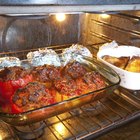
How Does a Convection Oven Work?
Convection Broiling Vs. Convection ...

Difference Between Baking on the Top & ...
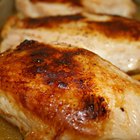
How to Make Pollo Asado-Marinated ...
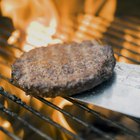
How to Convert a Brinkman Smoker From ...

How to Bake With a Roaster

Can You Cook Dessert & Dinner in the ...
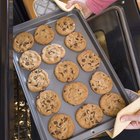
Do You Double the Time When Baking Two ...

The Difference Between Grill & Griddle
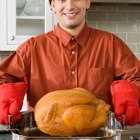
Difference Between a Broiling & ...

How to Make Pan-Seared Baked Steak

Cooking With a Countertop Halogen Lamp
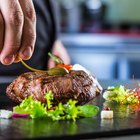
How to Cook Steak on FlavorWave

How to Use a Probe Cooking Thermometer

Can You Bake Sliders?

Substitute for a Springform Pan

Can You Bake Something Half Way & Then ...

Does a Roaster Oven Cook Faster Than ...
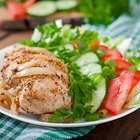
How to Cook Chicken Breasts in a ...

How to Use an Indoor Electric Grill
References
Writer Bio
Nannette Richford is an avid gardener, teacher and nature enthusiast with more than four years' experience in online writing. Richford holds a Bachelor of Science in secondary education from the University of Maine Orono and certifications in teaching 7-12 English, K-8 General Elementary and Birth to age 5.
Photo Credits
Ryan McVay/Photodisc/Getty Images